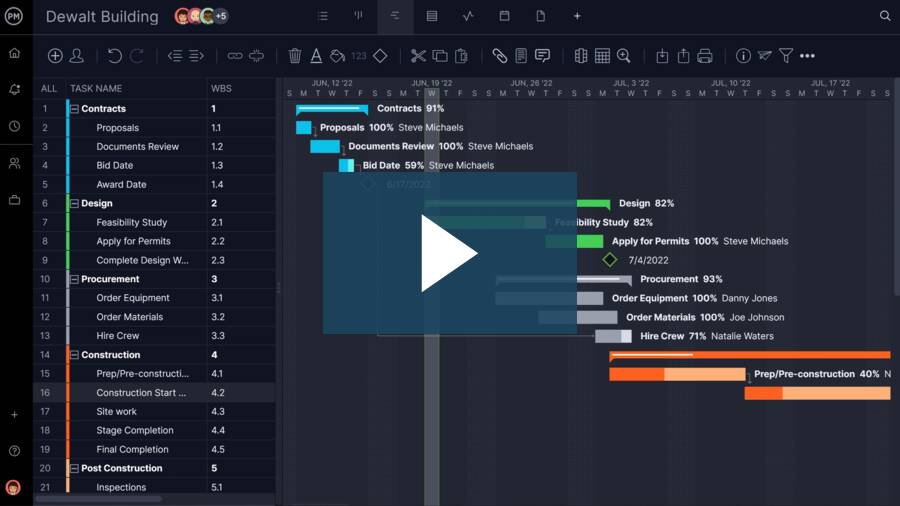A construction proposal is a key document to outline a construction project’s scope, cost and schedule. Whether responding to a formal bid or presenting your services to a client, a clear and detailed proposal builds trust and improves your chances of winning the project. In this guide, we’ll show you how to write one effectively.
What Is a Construction Proposal?
A construction proposal is a formal document that outlines the details of a construction project, including scope of work, materials, timeline, costs and terms and conditions.
In construction project management, the proposal is essential for setting clear expectations between the contractor and client. It helps prevent disputes, keeps everyone aligned and serves as the foundation for the project agreement.
If the construction proposal is accepted and the project moves forward, then the information collected on that construction project proposal will be instrumental in creating a schedule. The general contractor will use construction project management software with Gantt charts to outline project phases, with start and finish dates, dependencies and milestones.
However, not all construction project management is created equal. That’s why construction professionals use ProjectManager, award-winning construction project and portfolio management software with robust Gantt charts to schedule tasks, resources and costs.
More than that, our Gantt chart links all four types of task dependencies to avoid cost overruns and bottlenecks. It can also filter for the critical path to identify those tasks that must be completed with zero slack. Finally, set a baseline to track progress in real time and ensure the requirements of the construction proposal are met. Get started with ProjectManager today for free.
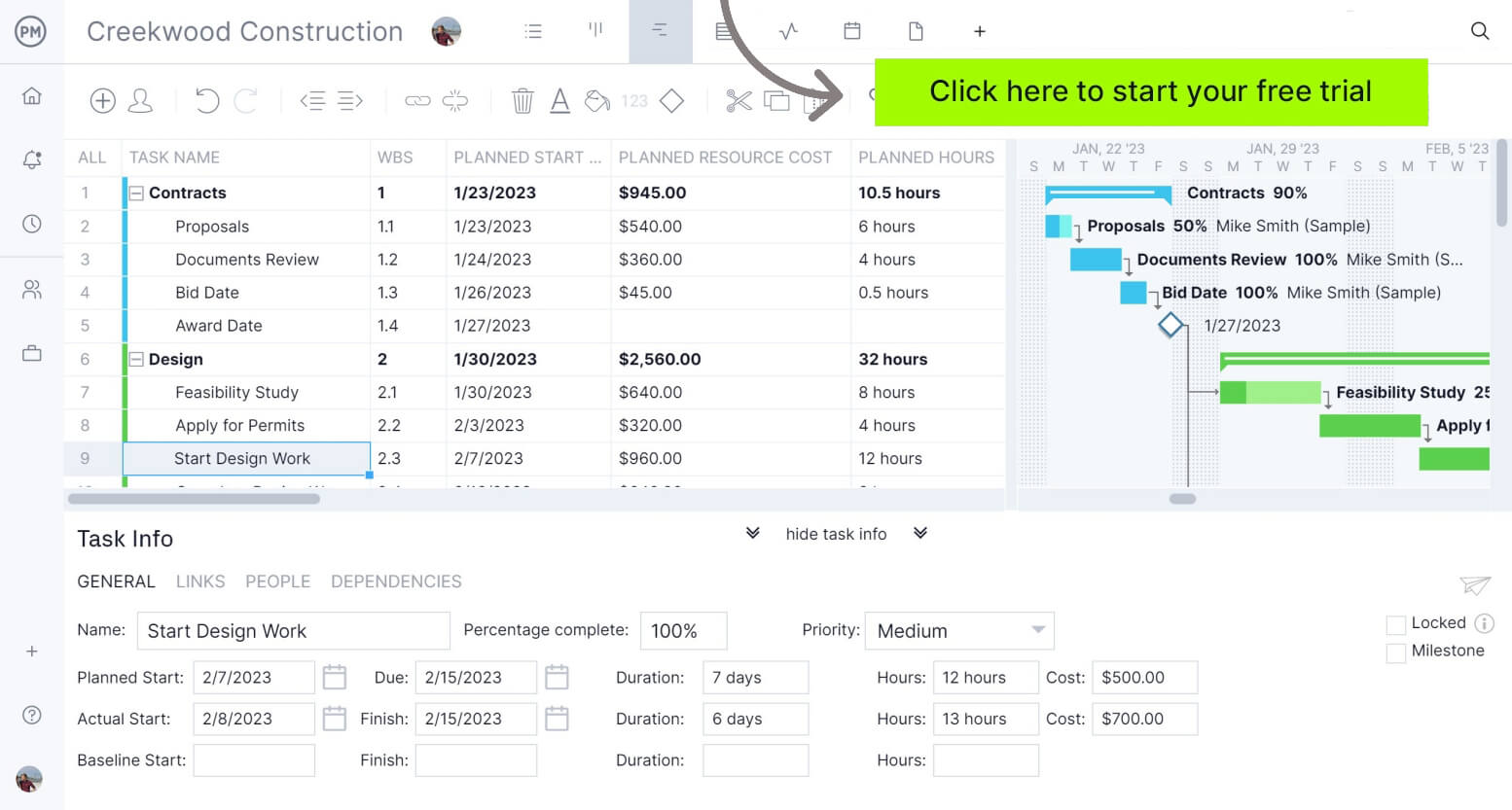
When to Write a Construction Proposal
There are several situations in which writing a construction proposal is essential. These include formal bid responses, design-build projects and the precontract phase of construction.
As a Response to a Request for Proposal (RFP) or an Invitation to Bid (ITB)
When a client issues an RFP or ITB, contractors submit a construction proposal detailing how they’ll meet the project requirements. It shows the client you’ve understood the scope and can complete the job on time and on budget.
To Stand Out During a Competitive Construction Bidding Process
In competitive bidding situations, a well-crafted proposal can help you rise above the competition. It not only presents pricing but also showcases your experience, approach and value-added services that differentiate your business from others.
When Developing a Design-Build Project
For design-build projects, a construction proposal outlines the design and construction elements. It helps clarify deliverables, phases and costs early, establishing transparency between the contractor and client from the outset.
During the Preconstruction Phase, Before Signing a Contract
Before formal agreements are signed, a proposal helps finalize discussions around scope and budget. It serves as a basis for negotiation, ensuring all parties are aligned before construction work begins.
Construction Proposal Example
Now that we’ve learned what a construction proposal is and what it should include, let’s take a look at an example. To keep things simple, we’ve created a proposal that a plumbing subcontractor would send to a general contractor to be selected to execute a specific scope of work within the larger project. Download this construction proposal example by clicking the image below.
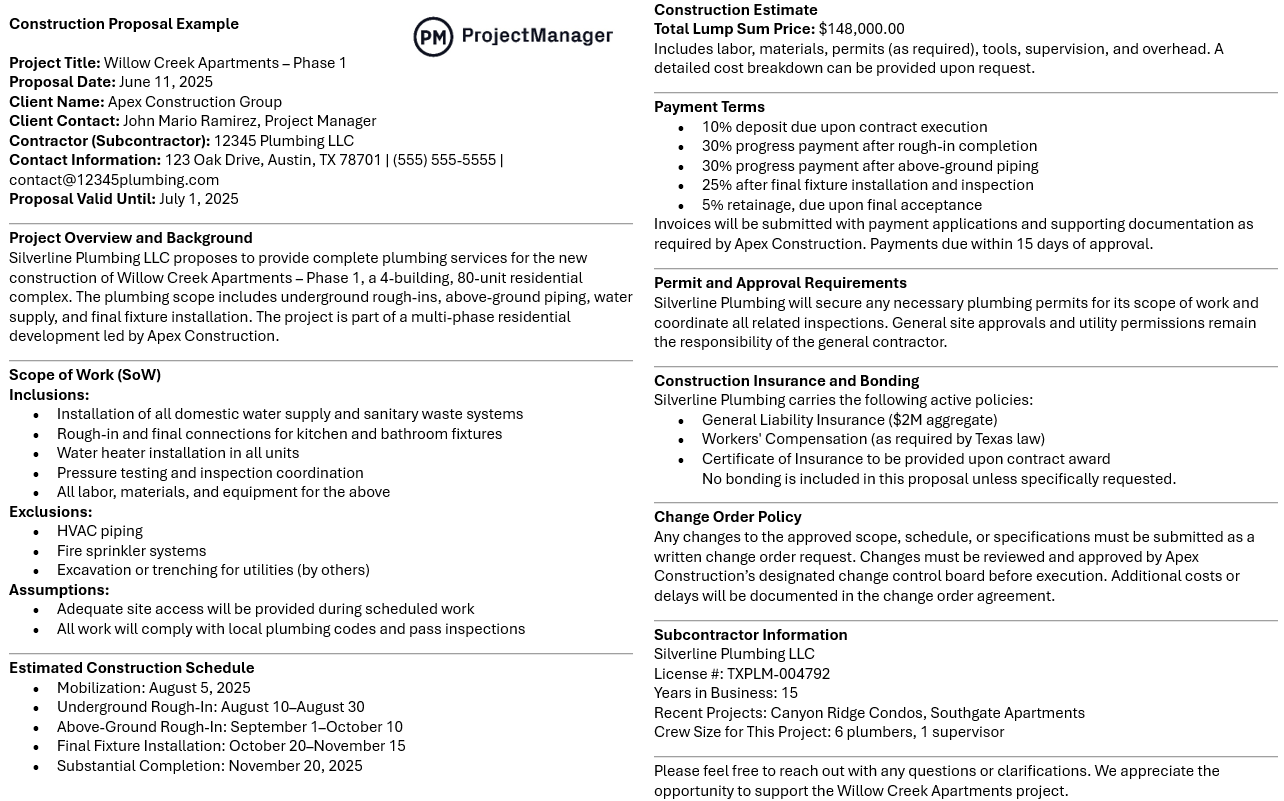
Who Prepares and Submits a Construction Proposal?
Depending on the project type and delivery method, several parties might be responsible for preparing and submitting a construction proposal.
- General Contractor: A general contractor usually prepares a construction proposal when bidding on traditional design-bid-build projects. They outline the full scope of construction based on architectural plans and subcontractor quotes. They may also submit proposals directly to owners or developers when managing the overall construction process.
- Subcontractor: Subcontractors prepare proposals when bidding for specific scopes of work, such as plumbing, electrical or HVAC, under a general contractor. These proposals often detail labor, materials and schedules for their portion of the project. Subcontractor proposals are typically submitted to general contractors, not directly to the client.
- Design-Build Firm: In design-build projects, the firm handling design and construction submits one comprehensive proposal. This includes architectural plans, engineering input and construction costs. These firms often submit directly to the project owner or developer and are responsible for delivering a turnkey solution.
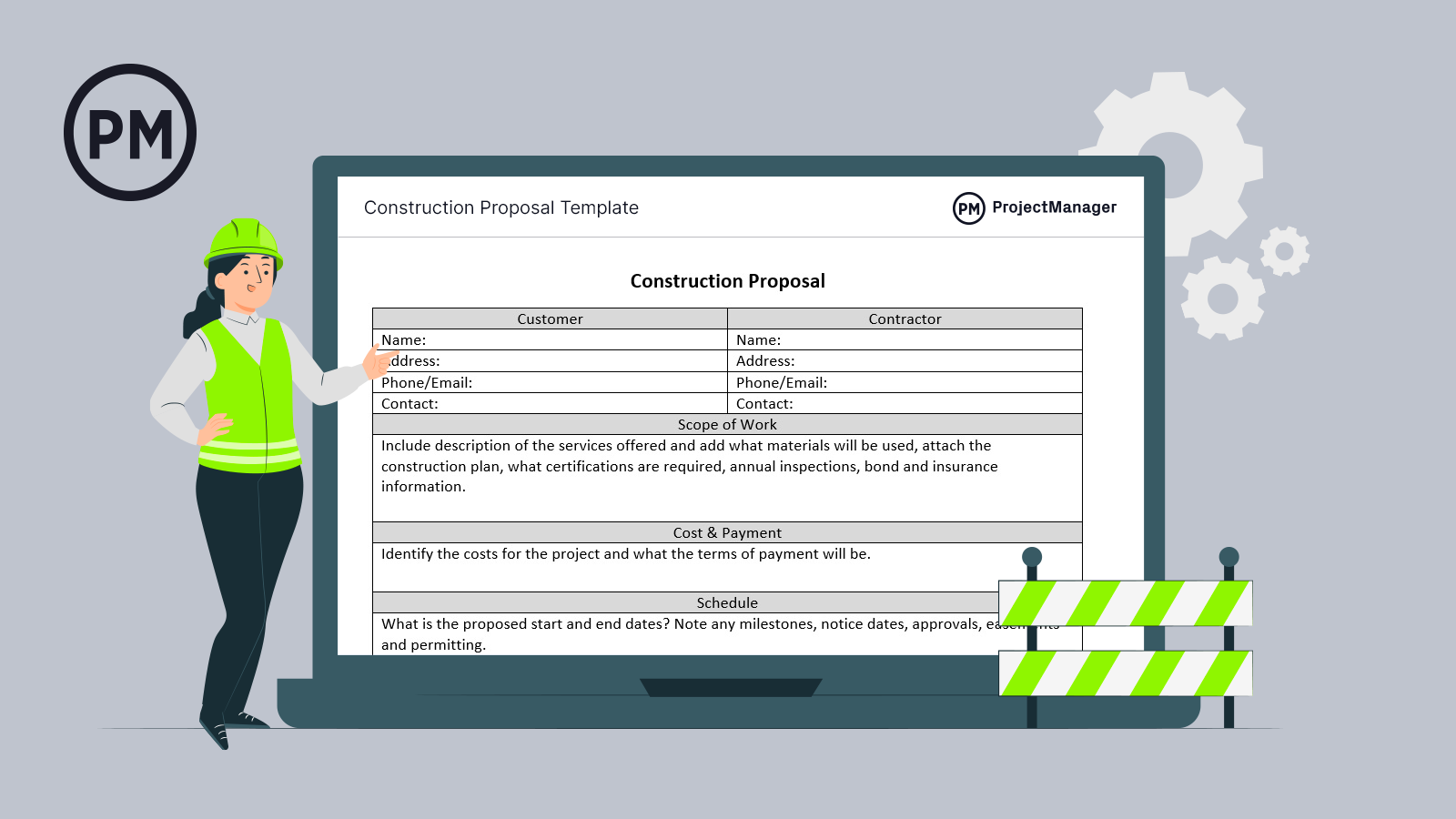
Get your free
Construction Proposal Template
Use this free Construction Proposal Template to manage your projects better.
Get the Template
Who Receives and Evaluates the Construction Proposal?
Different stakeholders may review construction proposals depending on the project’s structure, ownership and funding model.
- Project Owner: The project owner, whether a private client, corporation or government agency, often receives and evaluates proposals directly. They review pricing, timelines and experience to select the best contractor or design-build team to execute the work.
- Project Developer: In larger commercial or residential developments, the developer may be responsible for evaluating a construction proposal. They consider construction feasibility, overall project cost and alignment with project goals before selecting a contractor or team.
- Architect and Design Team: While not always the final decision-makers, architects and design teams may review proposals to ensure constructability, adherence to design intent, and compatibility with project specifications. Their input can influence the owner’s selection.

What Should Be Included in a Construction Proposal?
A construction proposal should contain all the key information a client needs to evaluate the offer. From general details to technical specifics, the proposal must be complete, organized and easy to understand.
General Information About the Construction Proposal
This section presents essential details that identify the proposal and provide context to the client. It includes names, dates and contact information that help establish transparency and facilitate communication. This information is usually listed at the beginning of the document for quick reference and verification.
Project Overview and Background
The project overview summarizes the proposed construction work, including high-level goals and the type of work to be completed. The background provides important context for why the project is being undertaken, such as its history, funding source, location challenges or relevant stakeholder objectives. Together, they demonstrate that the construction proposal preparer has a holistic understanding of the project.
Scope of Work (SoW)
The scope of work defines the specific tasks, deliverables, and services that the contractor will provide. It outlines what is included in the project (inclusions), what is not included (exclusions), and any assumptions that have been made when developing the proposal. This clarity helps prevent misunderstandings and disputes during execution. A well-defined SoW ensures all parties understand their responsibilities, the limits of the contractor’s obligations and the conditions under which the work is to be performed.
Estimated Construction Schedule
The construction schedule outlines the anticipated timeline for completing the project. It includes key milestones, phases and the projected start and end dates. In a construction proposal, this schedule helps the client understand how long the work will take and when major deliverables will be completed. A clear schedule sets expectations for project duration and helps coordinate with other contractors or stakeholders involved.
Related: 18 Best Construction Scheduling Software of 2025
Construction Estimate
The construction estimate provides a detailed breakdown of the projected costs associated with the project. This includes labor, materials, equipment, subcontractors, overhead, and profit. The estimate should align with the scope of work and reflect current market rates. In a construction proposal, the estimate helps the client assess affordability and compare bids. A transparent and realistic estimate builds trust and supports successful negotiations.
Payment Terms
Payment terms specify how and when the contractor expects to be paid throughout the project. This typically includes a payment schedule based on project milestones, phases or monthly progress. Other elements may include required deposits, retainage (a percentage withheld until project completion), late payment penalties and accepted payment methods. Proposals may also reference payment applications or invoicing procedures. Clear payment terms help manage cash flow and avoid disputes between the contractor and client.
Estimated Construction Schedule
The construction schedule outlines the anticipated timeline for completing the project. It includes key milestones, phases and the projected start and end dates. In a construction proposal, this schedule helps the client understand how long the work will take and when major deliverables will be completed. A clear schedule sets expectations for project duration and helps coordinate with other contractors or stakeholders involved.
Related: 20 Free Construction Excel Templates
Permit and Approval Requirements
Permit and approval requirements outline the legal and regulatory authorizations needed to begin and complete the construction project. This may include building permits, zoning approvals, environmental clearances and inspections. In a construction proposal, this section identifies who is responsible for obtaining each permit and the anticipated timeline for approvals. Including this information shows due diligence and reduces the risk of delays due to noncompliance.
Construction Insurance and Bonding
This section describes the types of insurance and bonds the contractor will carry for the project’s duration. Common policies include general liability, workers’ compensation, and builder’s risk insurance. Bonds may include bid bonds, performance bonds and payment bonds. Including construction insurance and bonding information in the proposal assures the client that the project and all involved parties are protected from financial and legal risk.
Change Order Policy
The change order policy outlines how changes to the original scope of work, schedule, or budget will be handled after the contract is signed. It typically describes the process for submitting a change order request and the role of the change control board in reviewing and approving changes. This section ensures that changes are managed in a structured, documented way to avoid disputes and project disruptions.
Subcontractor Information
Subcontractor information lists the trades or specialists hired to perform specific parts of the work. This may include electricians, plumbers, HVAC technicians or structural steel installers. The construction proposal may include company names, roles, licensing details and previous experience. Including this information demonstrates transparency, supports quality assurance and helps the client assess the reliability of the entire project team.
Construction Proposal Template
This construction proposal template contains some key elements that should be included in a proposal. It can be easily customized depending on the complexity and detail required for your construction proposals.
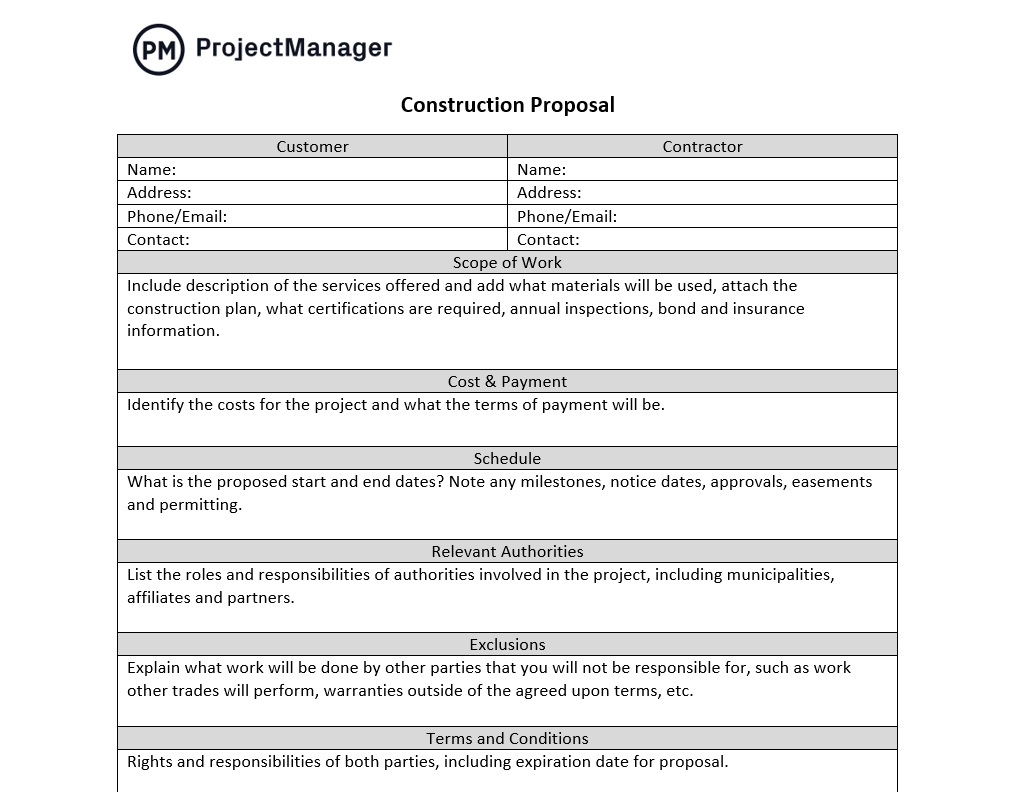
Download this free construction proposal template for Word to get started.
Benefits of Making a Thorough Construction Proposal
A well-prepared construction proposal offers more than just a cost breakdown. It supports decision-making, builds trust and lays the groundwork for a successful construction project.
Sets Clear Stakeholder Expectations
A thorough construction proposal defines the scope, schedule, budget and responsibilities from the start. This clarity ensures all stakeholders—owners, contractors and subcontractors—are on the same page, reducing the potential for misunderstandings and aligning everyone’s expectations.
Increases the Success Ratio When Bidding for Projects
Detailed proposals demonstrate professionalism, preparation, and value. They allow clients to evaluate your offer with confidence and compare it fairly against others. Showcasing your understanding of the project and providing transparent information improves your chances of winning competitive bids.
Sets the Stage for the Development of a Construction Plan
A well-crafted proposal serves as the foundation for a construction plan. It outlines deliverables, timelines and resource needs, all of which can be expanded into detailed project plans, schedules and budgets once the contract is awarded and work begins.
Reduces the Likelihood of Unforeseen Risks
By addressing assumptions, exclusions and change management protocols, a comprehensive proposal anticipates potential issues early. This proactive approach helps reduce the chances of delays, cost overruns, or disputes that could arise during construction due to unclear terms or missing information.
How to Manage Construction Projects With ProjectManager
ProjectManager is an ideal solution for construction teams looking to streamline project delivery with built-in resource planning, cost tracking and dynamic scheduling tools. We’ve already shown how our interactive Gantt chart allows you to map every phase of your build while linking tasks to real-time labor availability and budgets.
Color-coded workload charts show resource allocation and allow project managers to balance the team’s workload to keep them productive. There’s also a team page that provides a daily or weekly overview of their work. It can be filtered by progress or priority and tasks updated without leaving the page.
Work How You Want With Multiple Construction Project Management Views
Once a plan is created on the Gantt chart, it’s also available on multiple project views, from the sheet, calendar and task view to kanban boards. The task list view offers a clean, filterable breakdown of all assigned work—organized by due date, priority, assignee or status—so the construction crew and subcontractors can see exactly what needs to be done each day without digging through a Gantt chart. This is particularly useful on-site, where crews need quick, actionable updates on mobile devices.
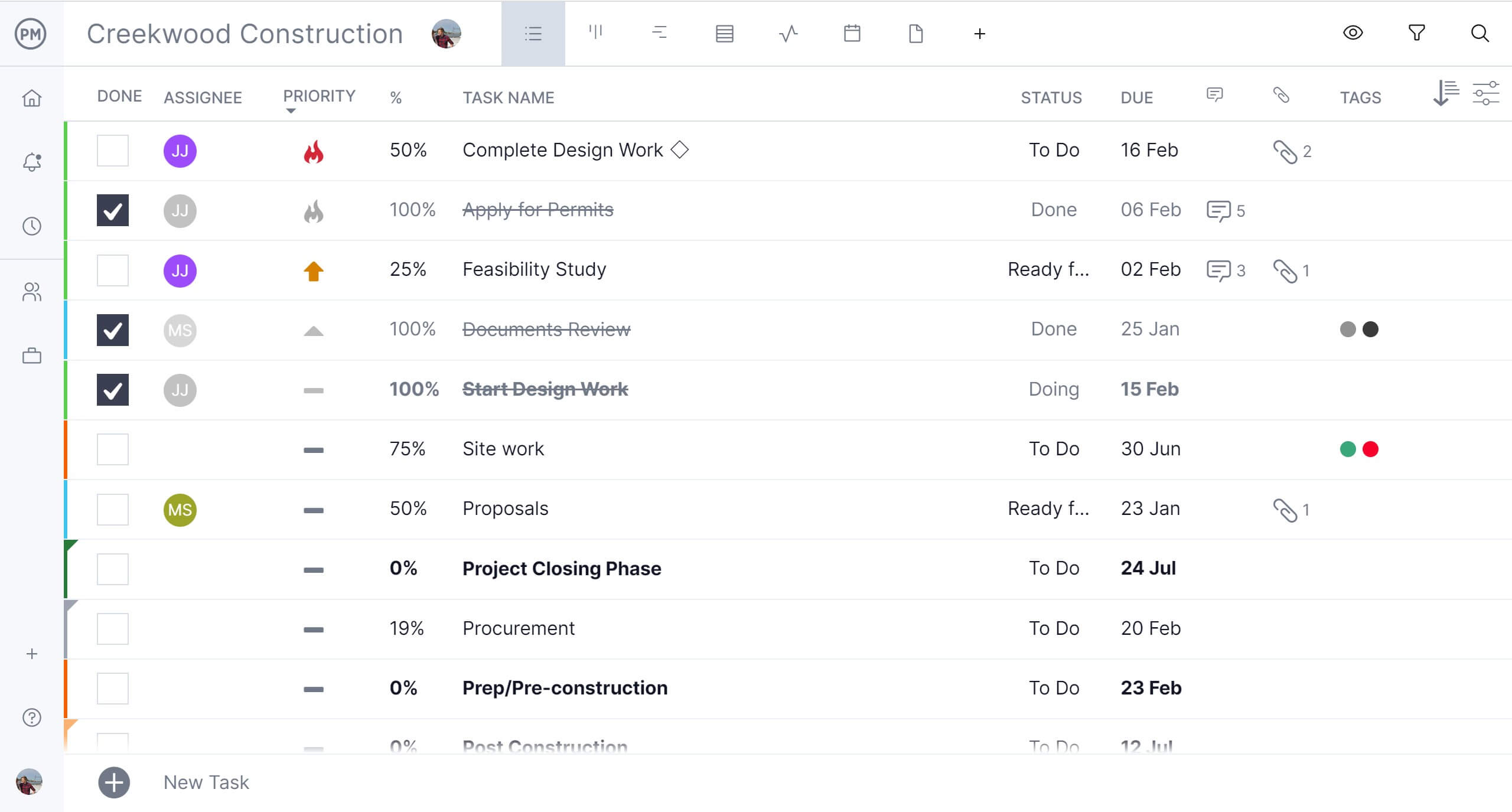
Track Progress on Real-Time Project Management Dashboards and Reports
Unlike spreadsheets or static tools, ProjectManager gives you live insights through real-time dashboards, customizable reports and integrated timesheets—ensuring you catch delays, stay on budget and keep crews aligned. Whether you’re managing subcontractors, equipment rentals or tight deadlines, our tracking features bring all your planning and execution into one intuitive platform built for construction success.
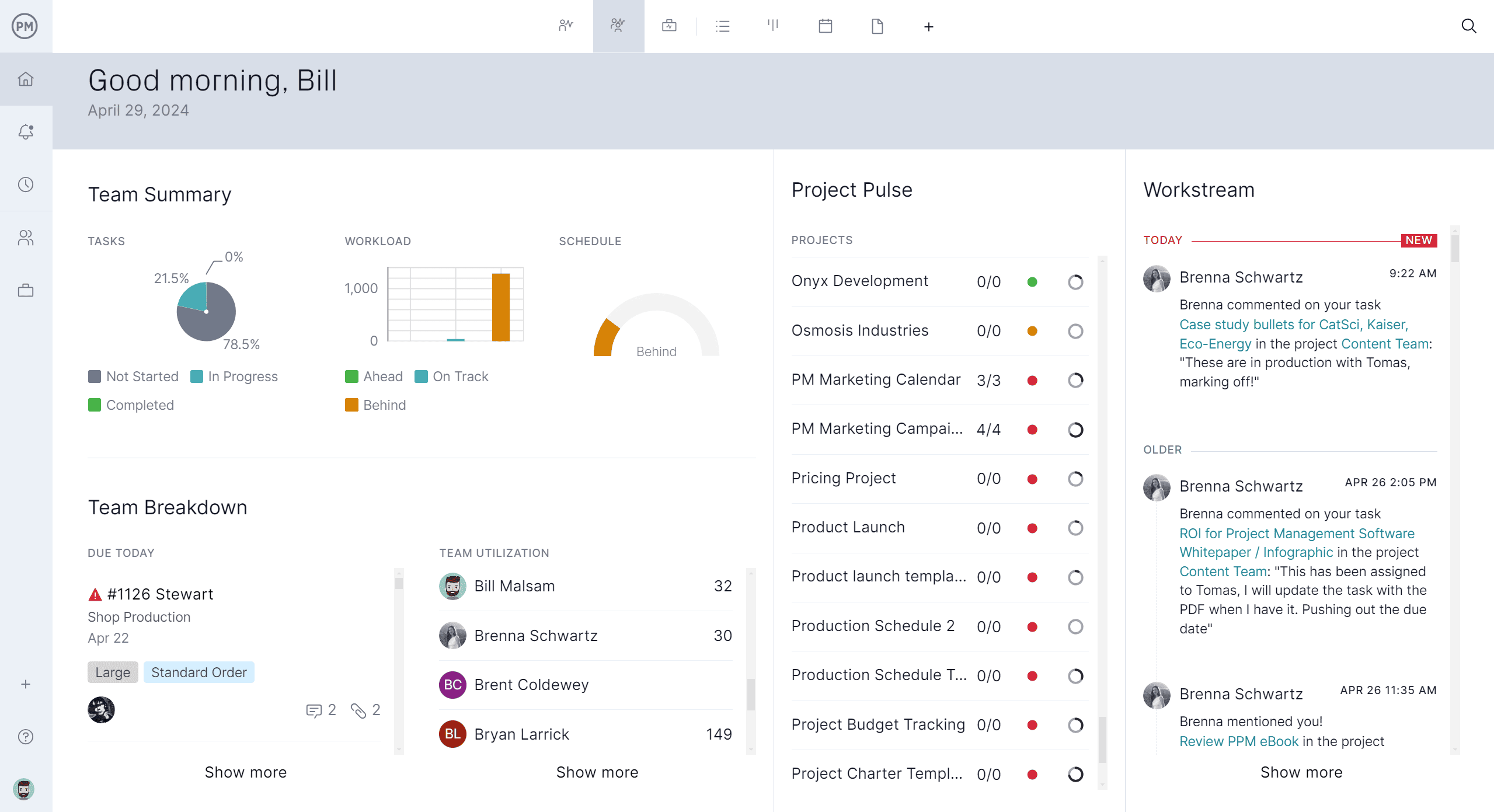
Related Content
Learn more about how to write a construction proposal. For those interested, follow the links below to read articles that help with writing, submitting, organization and more.
- 5 Proposal Examples with Analysis, Free Samples & Templates
- Construction Proposal Template
- 12 Free Proposal Templates for Submitting Proposals
- RFP Template (Request for Proposal) – Free Word Download
- How to Write a Work Proposal (with Example & Template)
- How to Write a Project Proposal (Examples & Template Included)
- How to Write a Service Proposal: Sample & Template
- How to Write a Bid Proposal (Templates Included)
ProjectManager is online construction project and portfolio management software that connects teams, whether they’re in the office or on the job site. They can share files, comment at the task level and stay updated with email and in-app notifications. Join teams at Avis, Nestle and Siemens who are using our software to deliver successful projects. Get started with ProjectManager today for free.

